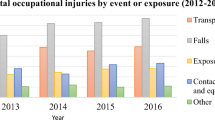Abstract
While there exist many systems in the literature for detecting unsafe behaviors of workers in buildings such as staying-in or stepping into unauthorized locations called intrusions using spatio-temporal data. None of the current approaches offer a mechanism for detecting intrusions from the perspective of a dynamic environment where the building locations evolve over time. A spatio-temporal data model that is required to store worker trajectories should have a capability to track a building evolution and seamlessly handles the enrichment of stored trajectories with the relevant geographical and application-specific information sources for studying the worker behaviors using a building or a construction site context. To address this requirement of maintaining the information, which is generated during the building evolution and for constructing semantically enriched worker trajectories using the stored building information. This work reports a system which offers the ability to perform user profiling for detecting intrusions in dynamic environments using semantic trajectories. Later, Building information modeling (BIM) approach is used for visualizing the intrusions from a standpoint of a building environment so that necessary actions can be performed proactively by the safety managers to avoid unsafe situations in buildings.
Access this chapter
Tax calculation will be finalised at checkout
Purchases are for personal use only
Similar content being viewed by others
References
Heng, L., Shuang, D., Skitmore, M., Qinghua, H., Qin, Y.: Intrusion warning and assessment method for site safety enhancement. Saf. Sci. 84, 97–107 (2016)
Wu, W., Yang, H., Chew, D.A., Yang, S.H., Gibb, A.G., Li., Q.: Towards an autonomous real-time tracking system of near-miss accidents on construction sites. Autom. Constr. 19(2), 134–141 (2010)
HSE, Investigating accidents and incidents. http://www.hse.gov.uk/pubns/hsg245.pdf. Last accessed 01 Oct 2018
Williams, T., Bernold, L., Lu, H.: Adoption patterns of advanced information technologies in the construction industries of the United States and Korea. J. Constr. Eng. Manag. 133(10), 780–790 (2007)
Zheng, Y.: Trajectory data mining: an overview. ACM Trans. Intell. Syst. Technol. (TIST) 6(3), 29 (2015)
Teizer, J., Cheng, T.: Proximity hazard indicator for workers-on-foot near miss interactions with construction equipment and geo-referenced hazard areas. Autom. Constr. 60, 58–73 (2015)
Yan, Z.: Semantic trajectories: computing and understanding mobility data. Doctoral dissertation, Lausanne, EPFL (2011)
Becerik-Gerber, B., Jazizadeh, F., Li, N., Calis, G.: Application areas and data requirements for BIM-enabled facilities management. J. Constr. Eng. Manag. 138(3), 431–442 (2011)
Naticchia, B., Vaccarini, M., Carbonari, A.: A monitoring system for real-time interference control on large construction sites. Autom. Constr. 29, 148–160 (2013)
Fang, Q., Li, H., Luo, X., Ding, L., Rose, T.M., An, W., Yu, Y.: A deep learning-based method for detecting non-certified work on construction sites. Adv. Eng. Inform. 35, 56–68 (2018)
Carbonari, A., Giretti, A., Naticchia, B.: A proactive system for real-time safety management in construction sites. Autom. Constr. 20(6), 686–698 (2011)
Wu, W., Yang, H., Li, Q., Chew, D.: An integrated information management model for proactive prevention of struck-by-falling-object accidents on construction sites. Autom. Constr. 34, 67–74 (2013)
Fang, Y., Cho, Y.K., Zhang, S., Perez, E.: Case study of BIM and cloud—enabled real-time RFID indoor localization for construction management applications. J. Constr. Eng. Manag. 142(7), 05016003 (2016)
Yang, H., Chew, D.A., Wu, W., Zhou, Z., Li, Q.: Design and implementation of an identification system in construction site safety for proactive accident prevention. Accid. Anal. Prev. 48, 193–203 (2012)
Ding, L.Y., Zhou, C., Deng, Q.X., Luo, H.B., Ye, X.W., Ni, Y.Q., Guo, P.: Real-time safety early warning system for cross passage construction in Yangtze Riverbed Metro Tunnel based on the internet of things. Autom. Constr. 36, 25–37 (2013)
Albanna, B.H., Moawad, I.F., Moussa, S.M., Sakr, M.A.: Semantic trajectories: a survey from modeling to application. In: Information Fusion and Geographic Information Systems (IF&GIS’2015), pp. 59–76. Springer, Cham (2015)
Parent, C., Spaccapietra, S., Renso, C., Andrienko, G., Andrienko, N., Bogorny, V., Damiani, M.L., Gkoulalas-Divanis, A., Macedo, J., Pelekis, N., Theodoridis, Y.: Semantic trajectories modeling and analysis. ACM Comput. Surv. (CSUR) 45(4), 42 (2013)
Arslan, M., Cruz, C., Ginhac, D.: Understanding worker mobility within the stay locations using HMMs on semantic trajectories. In: 14th International Conference on Emerging Technologies (ICET), pp. 1–6. IEEE, Islamabad (2018)
Cruz, C.: Semantic trajectory modeling for dynamic built environments. In: Data Science and Advanced Analytics (DSAA), pp. 468–476. IEEE, Tokyo (2017)
Autodesk. http://paulaubin.com/_downloads/2017_AU/BIM128338-Aubin-AU2017.pdf. Last accessed 01 Oct 2018
Azhar, S.: Building information modeling (BIM): trends, benefits, risks, and challenges for the AEC industry. Leadersh. Manag. Eng. 11(3), 241–252 (2011)
Acknowledgements
The authors thank the Conseil Régional de Bourgogne-Franche-Comté, the French government for their funding, SATT Grand-Est, and IUT-Dijon (http://iutdijon.u-bourgogne.fr). The authors also want to thank Orval Touitou for his technical assistance to this research work.
Author information
Authors and Affiliations
Corresponding author
Editor information
Editors and Affiliations
Rights and permissions
Copyright information
© 2020 Springer Nature Singapore Pte Ltd.
About this paper
Cite this paper
Arslan, M., Cruz, C., Ginhac, D. (2020). Identifying Intrusions in Dynamic Environments Using Semantic Trajectories and BIM for Worker Safety. In: Yang, XS., Sherratt, S., Dey, N., Joshi, A. (eds) Fourth International Congress on Information and Communication Technology. Advances in Intelligent Systems and Computing, vol 1027. Springer, Singapore. https://doi.org/10.1007/978-981-32-9343-4_6
Download citation
DOI: https://doi.org/10.1007/978-981-32-9343-4_6
Published:
Publisher Name: Springer, Singapore
Print ISBN: 978-981-32-9342-7
Online ISBN: 978-981-32-9343-4
eBook Packages: EngineeringEngineering (R0)




